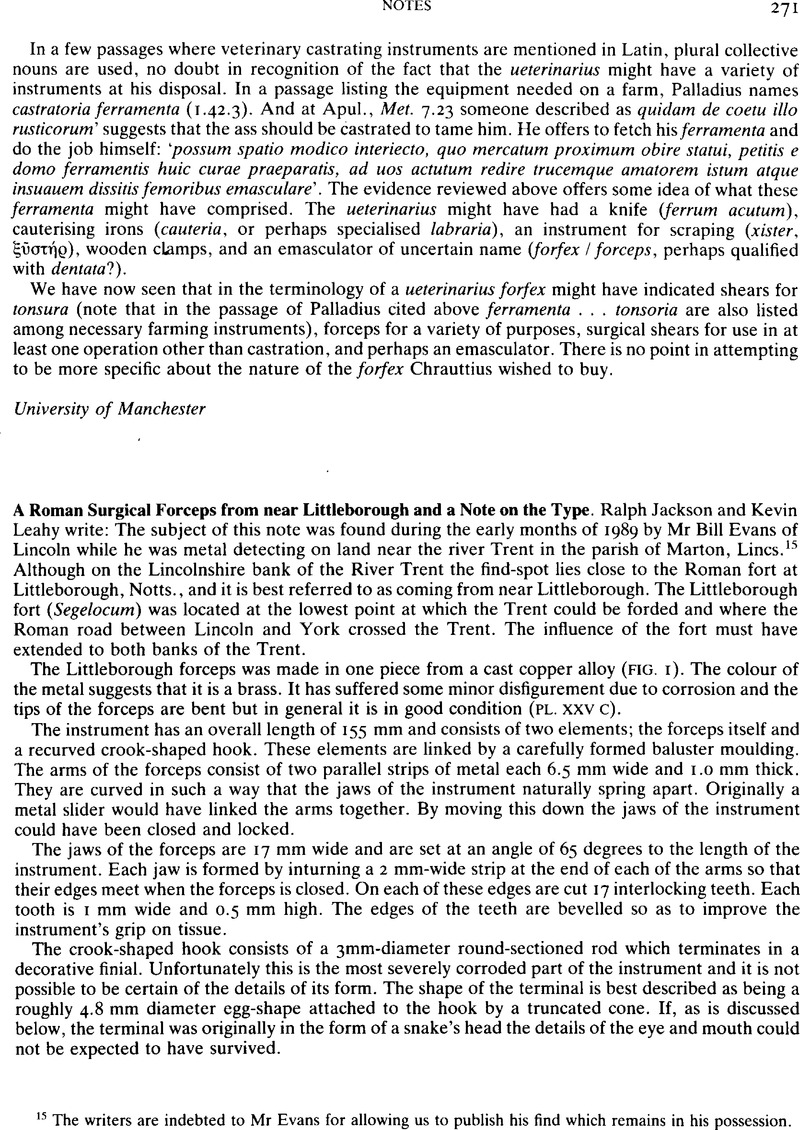No CrossRef data available.
Article contents
A Roman Surgical Forceps from near Littleborough and a Note on the Type.
Published online by Cambridge University Press: 09 November 2011
Abstract

- Type
- Notes
- Information
- Copyright
- Copyright © Ralph Jackson and Kevin Leahy 1990. Exclusive Licence to Publish: The Society for the Promotion of Roman Studies
References
16 Boon, G.C., Silchester: the Roman town of Calleva (London, 1974), 137Google Scholar, fig. 16, no. 7 (an idealised drawing).
17 Sorel, P. in Lutèce, Paris de Cesar à Clovis (Paris, 1984), pl. XVIIGoogle Scholar, nos. pl and p3, 231, fig. 133C.
18 Künzl, E., Medizinische Instrumente aus Sepulkralfunden der römischen Kaiserzeit (Bonn, 1983), fig. 10, 2.Google Scholar
19 ibid., fig. 86,4.
20 Jackson, R., Britannia xvii (1986), 122–3, 138–9, fig. I, II.Google Scholar
21 Milne, J.S., Surgical instruments in Greek and Roman times (Oxford, 1907; repr. Chicago, 1970), pl. xxix, 4.Google Scholar
22 Møller-Christensen, V., The history of the forceps (London and Copenhagen, 1938), 129–30, fig. 197.Google Scholar
23 ibid., 129–30, fig. 198.
24 Künzl, E. in Feugère, M.et al., Jahrbuch RGZM xxxii (1985), pl. 60, 2d.Google Scholar
25 Cüppers, H., Kranken- und Gesundheitspflege in Trier und dem Trierer Land von der Antike bis zur Neuzeit (Trier, 1981), 27–8Google Scholar, fig. 16, 4; Künzl, E., Trierer Zeitschrift xlvii (1984), 162, 212, pl. 8, D2.Google Scholar
26 See e.g. Johns, C.M., ‘Snakes in Roman art’ in Henig, M. (ed.), Roman art and architecture (O.U.C.A., forthcoming).Google Scholar
27 Jackson, R., Doctors and diseases in the Roman empire (London, 1988), 138ff.Google Scholar
28 Künzl, op. cit. (note 18), fig. 80, 1.
29 ibid., fig. 18, 8; Meyer-Steineg, Th., Jenaer medizin-historische Beiträge i (1912), pl. 11, 1.Google Scholar
30 Meyer-Steineg, Th. and Sudhoff, K., Geschichte der Medizin im Überlick mit Abbildungen (Jena, 1921), fig. 74.Google Scholar
31 Jackson, op. cit. (note 20), table 1, nos. 5–9.
32 op. cit. (note 21), 97; Paulus Aegineta, VI, viii.
33 op. cit. (note 16), 137.
34 op. cit. (note 22), 147–50, fig. 217.
35 Galen XIV, 790K; Celsus, De Medicina VII, 31. To illustrate the fortitude of C. Marius, Pliny (Natural History XI, civ) noted that he was the only man known to have endured this operation without lying down.
36 Paulus Aegineta VI, xxxi and VI, lxxix; Milne, op. cit. (note 21), 97–8, pls. xxx-xxxn; Jackson, op. cit. (note 27), 124–5, pl- 32.
37 see Künzl, E., Archäologisches Korrespondenzblatt xiii (1983), pl. 63Google Scholar, 1 and Jackson, op. cit. (note 20), 142, fn. 80.
38 Jackson, op. cit. (note 20), 140–3.
39 ibid., 141.
40 Gentleman's Magazine xlii (1772), 415; CIL vu, 1321a. If the sketch in the Gentleman's Magazine is a full-size drawing, the stamp measures about 57 × 31 × 6 mm. Inscriptions were observed on both short sides but on only one of the long sides. Way, Albert (Arch. Journ. vii (1850))Google Scholar recorded that the stamp had been ‘accidentally lost’, and its present whereabouts remains unknown. The complete reading is uncertain, but DIASORICV (DIAPSORICUM) and STATUS, STACT (STACTUM) are the two collyria specified, apparently ‘for clearing the sight’ – AT CLARI (AD CL ARIT ATEM). DIAPSORI(CUM) AD CLAR(ITATEM) is also inscribed on a stamp from Bath (JRS xiv (1924), 247). Voinot (Conferences Lyonnaises d'ophtalmologie cl (1981–2) 1984, 1–578) has collated most (284) of the known collyrium stamps. Analysis of his data shows 78 occurrences of the phrase AD CLARITATEM, for which STACTUM and DIAPSORICUM are the commonest recommended collyria - 16 occurrences each.




